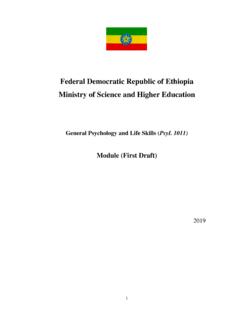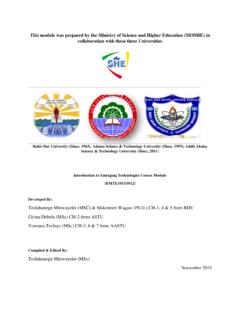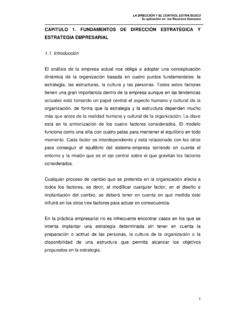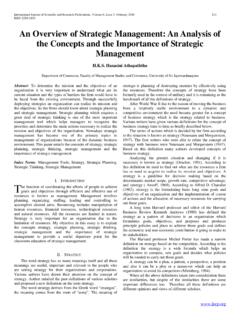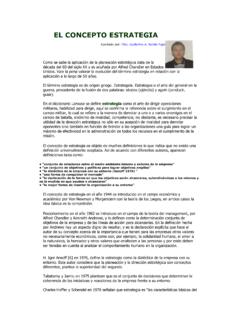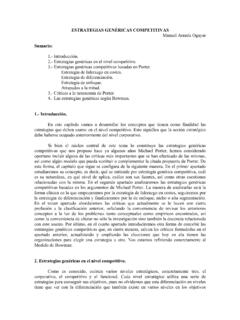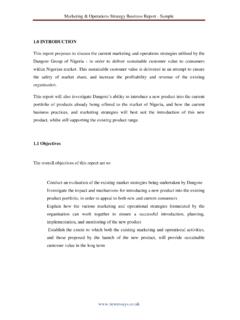Transcription of Entrepreneurship - WCU
1 Entrepreneurship Ministry of Science and Higher Education (MoSHE) Prepared by: Bantie Workie (PhD) Mulugeta Chane (MBA) Mustefa Mohammed (MBA) Teshale Birhanu (PhD) Addis Ababa, Ethiopia September 2019 i Contents Introduction ..1 chapter 1: The Nature of Entrepreneurship ..2 INTRODUCTION ..2 Historical Origin of Entrepreneurship ..2 Definitions of Entrepreneurship and Entrepreneur ..3 Types of Entrepreneurs ..5 Role of Entrepreneurs in Economic Development ..6 Entrepreneurial Competence and Environment ..8 Entrepreneurial Mindset ..8 Entrepreneurship and Environment .. 22 Creativity, Innovation and Entrepreneurship .. 26 Creativity .. 26 2 Innovation .. 27 From Creativity to Entrepreneurship .. 29 Summary.
2 29 Review Questions .. 30 Chapter 2: Business Planning .. 32 INTRODUCTION .. 32 Opportunity Identification and Evaluation .. 32 Business Idea Development .. 35 Business Idea Identification .. 37 The Need will Your Business Fulfill for the 37 Good or Service will your Business Sell .. 38 Identifies Potential Customer .. 39 Strategy for Selling Goods or Services/ How is Your Business Going to Sell Good or Services? .. 40 Relation between Business and Environment .. 40 Methods for Generating Business Ideas .. 41 Business Idea Screening .. 51 Concept of Business Plan .. 53 Developing a Business Plan .. 54 Business Planning Process .. 54 ii Essential Components of Business Plan .. 56 Sample Business plan Format .. 58 Summary .. 63 Review Questions .. 64 CHAPTER 3: BUSINESS FORMATION .. 65 INTRODUCTION .. 65 The Concept of Small Business Development .. 65 Forms of Business (A Short Explanation) .. 66 Definition and Role/Importance of MSEs in Developing Countries.
3 68 Definition of MSEs .. 68 Role/Importance of MSEs in Developing Countries .. 70 Setting up Small Scale Business .. 75 Small Business Failure and Success Factors .. 79 Small Business Failure Factors .. 79 Small Business Success Factors .. 82 Classification of Enterprises in Ethiopian Context .. 73 Main Supporting Packages for MSEs Development in Ethiopia .. 85 Problems of Small Scale Business in Ethiopia .. 85 Organizational Structure and Entrepreneurial Team Formation .. 86 Introduction .. 86 Designing the Organization .. 86 Building the Management Team and a Successful Organization Culture .. 88 Chapter Summary .. 90 Questions for Review and 91 CHAPTER 4: PRODUCT/SERVICE DEVELOPMENT .. 92 INTRODUCTION .. 92 The Concept of Product/Service Technology .. 92 Product/Service Development Process .. 93 Legal and Regulatory Frameworks for Entrepreneurs .. 98 Intellectual Property Protection/Product/Service Protection .. 98 What is Intellectual Property?
4 98 Patents .. 98 Trademarks .. 99 Copyrights .. 100 iii The Intellectual Property System in Ethiopia .. 100 Chapter Summary .. 103 Questions for Review and Discussions .. 104 CHAPTER 5: MARKETING .. 105 INTRODUCTION .. 105 Meaning and Definitions of Marketing .. 106 Core Concepts of Marketing .. 107 Needs, Wants and Demand .. 107 Importance of Marketing .. 108 Marketing Philosophies .. 110 Marketing Information Systems .. 113 Marketing Research .. 114 Marketing Intelligence .. 117 Competitive Analysis .. 118 The Marketing Mix Strategy .. 120 The 4 P s Of Marketing/The Marketing Mix .. 120 What Is Marketing Strategy? .. 121 Selling and of Customer 125 The Concept of Service .. 125 The Concept of Customer .. 126 Strategic Activities needed for Quality Customer Service Delivery .. 126 Customer Handling and Satisfaction .. 126 Chapter Summary .. 129 Review Questions .. 130 CHAPTER 6: BUSINESS FINANCING .. 132 INTRODUCTION.
5 132 Financial Requirements .. 132 Sources of Financing .. 134 Internal Sources (Equity capital) .. 134 External Sources (Debt capital) .. 136 Lease 141 Types of Lease .. 141 Traditional Financing in Ethiopian (Equib/Edir, Etc.) .. 143 Crowd Funding .. 145 iv How is Crowd Funding Different? .. 145 The Benefits of Crowd funding .. 146 Types of Crowd Funding .. 147 Micro Finances .. 147 What is Micro Finance? .. 147 Importance of MFIs .. 148 Micro Finances in Ethiopia .. 149 Chapter Summary .. 150 Review Questions .. 151 CHAPTER 7 MANAGING GROWTH AND 153 INTRODUCTION .. 153 Timmons Model of Entrepreneurship .. 153 New Venture Expansion Strategies .. 156 Introduction .. 156 Methods of Growth .. 157 The Ansoff Matrix Growth Strategy .. 158 Selecting a Product-Market Growth Strategy .. 159 Expansion 161 Choosing not to Grow .. 164 Business Ethics and Social Responsibility .. 164 Introduction .. 164 Three Approaches to Corporate Responsibility.
6 165 Business Ethics 172 Summary .. 174 Review Questions .. 175 1 INTRODUCTION The course, Entrepreneurship , has been offered to Ethiopian students of higher education in limited departments, such as management, Accounting, Agriculture and Engineering. However, as part of high education reform, it was decided the course, Entrepreneurship , to be one of the common courses for all freshman students. It aims to bring behavioral changes among students and support them develop self-employment mindset in their personal and professional lives. Among other things, it was also decided to prepare common teaching material for the course so that students may learn and instructors teach the course using the same material. For the task of preparing this teaching material, four subject matter experts have been drawn from Addis Ababa, Gondar, Haramaya and Wollo Universities. The team members prepared this teaching material by working severally and in-group both for writing and editing.
7 Course instructors are also expected to prepare additional cases, get access to videos and make the teaching process as learner centered. Such efforts may create entrepreneurial generation in Ethiopian economy in this digital age. This teaching material consists of seven chapters as prepared by more than 25 subject matter experts drawn from many universities. Chapter one deals with nature of Entrepreneurship . Chapter two addresses the concept of business planning. Chapter three discusses about business formation in terms of ownership. Chapter four is about product development using systematic and procedural approach. Chapter five treats basics of marketing. Chapter six, tries to identify the sources of financing for startup and when decided to grow. Chapter seven gives basics of business ethics and corporate social responsibility including the transition from start up to growth. The time given for the subject matter experts for the preparation of the material was very limited.
8 The members feel that the teaching material may not be complete in all aspects. Comments are welcome from students and instructors for making improvements in the quality of the material in the years to come. The team 2 CHAPTER 1: THE NATURE OF Entrepreneurship INTRODUCTION The word entrepreneur is widely used, both in everyday conversation and as a technical term in management and economics. Its origin from a French word, entreprender, where an entrepreneur was an individual commissioned to undertake a particular commercial project. A number of concepts have been derived from the idea of the entrepreneur such as entrepreneurial, Entrepreneurship and entrepreneurial process. The idea that the entrepreneur is someone who undertakes certain projects offers an opening to developing an understanding of the nature of Entrepreneurship . Undertaking particular projects demands that particular tasks be engaged in with the objective of achieving specific outcomes and that an individual take charge of the project.
9 Entrepreneurship is then what the entrepreneur does. Entrepreneurial is an adjective describing how the entrepreneur undertakes what he or she does. The entrepreneurial process in which the entrepreneur engages is the means through which new value is created as a result of the project: the entrepreneurial venture. Chapter Objectives This chapter is concerned with developing a predominant and integrated perspective of the entrepreneur and Entrepreneurship . It reviews the great variety of definitions given for the word Entrepreneurship and also the different activities performed by the entrepreneur. After completing this chapter, students will be able to: Define the term Entrepreneurship and entrepreneur Identify types of entrepreneur Recognize the role of Entrepreneurship in the economy Analyze the entrepreneurial competences Understand creativity and innovation Historical Origin of Entrepreneurship What is Entrepreneurship ?
10 And who is an entrepreneur? These two questions are asked more frequently reflecting the increasing demand in the field of Entrepreneurship . Offering a specific and unambiguous definition of the term Entrepreneurship /entrepreneur presents a challenge. This 3 is not because definitions are not available, but because there are so money. Here let us took in to the historical development of Entrepreneurship so as to grasp the meaning of the word Entrepreneurship . During the ancient period the word entrepreneur was used to refer to a person managing large commercial projects through the resources provided to him. In the 17th Century a person who has signed a contractual agreement with the government to provide stipulated products or to perform service was considered as entrepreneur. In this case the contract price is fixed so any resulting profit or loss reflects the effort of the entrepreneur. In the 18th Century the first theory of entrepreneur has been developed by Richard Cantillon.


